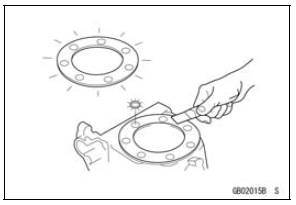

Hardening, shrinkage, or damage of both gaskets and O-rings after disassembly can reduce sealing performance.
Remove old gaskets and clean the sealing surfaces thoroughly so that no gasket material or other material remains.
Install the new gaskets and replace the used O-rings when re-assembling.

 Force
Force Liquid Gasket, Non-permanent Locking Agent
Liquid Gasket, Non-permanent Locking AgentRadiator and Radiator Fan Removal
Remove:
Upper Fairing Assembly (see Upper Fairing Assembly
Removal in the Frame chapter)
Coolant (Drain, see Coolant Change in the Periodic
Maintenance chapter)
Air Cleaner Housing (see Air Cleaner Housing Removal
in the Fuel System (DFI) chapter)
Coolant Reserve Tank (see Coolant R ...
Fuel Injector Fuel Line Inspection
Remove:
Fuel Tank (see Fuel Tank Removal)
Air Cleaner Housing (see Air Cleaner Housing Removal)
Disconnect:
Primary and Secondary Fuel Hoses (see Fuel Hose Replacement
in the Periodic Maintenance chapter)
Do not remove the nozzle assy from the air cleaner housing.
Be sure to pla ...
Hub Bearing Removal
Remove the wheels (see Front/Rear Wheel Removal),
and take out the following.
Collars
Coupling (Out of rear hub)
Grease Seals
Use the bearing remover to remove the hub bearings [A].
NOTICE
Do not lay the wheel on the ground with the disc
facing down. This can damage or warp the d ...